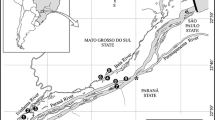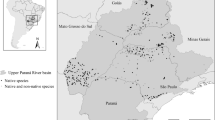Abstract
In communities or regions where non-native fish species still do not predominate, changes in the assemblage composition are driven by loss, gain or substitution by native species only. We investigated the native invasion hypothesis in small streams, in which human modifications may influence fish assemblage composition by boosting the expansion and establishment of widespread species, as well as of species commonly found in large streams and rivers. Fish community data from 54 lowland streams from South Brazil were used to investigate this hypothesis. We found a positive relationship between cropland cover at the catchment scale and the dominance of fish species that commonly inhabit large streams or rivers (inferred on museum records). We also observed a weak and negative relationship between site elevation and the percentage of widely distributed species in fish assemblages. Our results partly support the hypothesis of native invasion in lowland streams, but the low explanatory power of the models suggests that it is less pronounced compared to highland streams. Our results contribute to understand inconsistencies among studies on the effects of land use on stream fish assemblages using traditional metrics (alpha and beta diversities). For instance, land use can initially increase fish species richness in small streams by favouring the occurrence and establishment of fish species common to rivers. In this sense, alternative metrics that consider specific changes in native species distribution, such as proliferation of common species, should be used to better assess the mechanisms that drive changes in communities of aquatic ecosystems.



Similar content being viewed by others
References
Allan JD (2004) Landscapes and riverscapes: the influence of land use on stream ecosystems. Annu Rev Ecol Evol Syst 35:257–284
Bartón K (2018) MuMIn: multi-model inference. R package version 1.40.4. https://cran.r-project.org/package=MuMIn
Bates D, Maechler M, Bolker B, Walker S (2015) Fitting linear mixed-effects models using lme4. J Stat Softw 67:1–48
Burdon FJ, McIntosh AR, Harding JS (2013) Habitat loss drives threshold response of benthic invertebrate communities to deposited sediment in agricultural streams. Ecol Appl 23:1036–1047
Burnham KP, Anderson DR (2002) Model selection and multimodel inference: a practical information-theoretic approach. Springer, New York
Burrell TK, O’Brien JM, Graham SE, Simon KS, Harding JS, McIntosh AR (2014) Riparian shading mitigates stream eutrophication in agricultural catchments. Freshw Sci 33:73–84
Camana M, Dala-Corte RB, Becker FG (2016) Relation between species richness and stream slope in riffle fish assemblages is dependent on spatial scale. Environ Biol Fishes 99:603–612
Casatti L, Ferreira CP, Carvalho FR (2009) Grass-dominated stream sites exhibit low fish species diversity and dominance by guppies: an assessment of two tropical pasture river basins. Hydrobiologia 632:273–283
Casatti L, Teresa FB, Gonçalves-Souza T, Bessa E, Manzotti AR, Gonçalves CDS, Zeni JDO (2012) From forests to cattail: how does the riparian zone influence stream fish? Neotrop Ichthyol 10:205–214
Casatti L, Teresa FB, Zeni JO, Ribeiro MD, Brejao GL, Ceneviva-Bastos M (2015) More of the same: high functional redundancy in stream fish assemblages from tropical agroecosystems. Environ Manage 55:1300–1314
Copp GH, Bianco PG, Bogutskaya NG, Erős T, Falka I, Ferreira MT, Fox MG, Freyhof J, Gozlan RE, Grabowska J, Kováč V, Moreno-Amich R, Naseka AM, Peňáz M, Povž M, Przybylski M, Robillard M, Russell IC, Stakėnas S, Šumer S, Vila-Gispert A, Wiesner C (2005) To be, or not to be, a non-native freshwater fish? J Appl Ichthyol 21:242–262
Core Team R (2018) R: a language and environment for statistical computing. R Foundation for Statistical Computing, Vienna
Crossman EJ (1991) Introduced freshwater fishes: a review of the North American perspective with emphasis on Canada. Can J Fish Aquat Sci 48:46–57
Dala-Corte RB, Giam X, Olden JD, Becker FG, Guimarães TDF, Melo AS (2016) Revealing the pathways by which agricultural land-use affects stream fish communities in South Brazilian grasslands. Freshw Biol 61:1921–1934
Dala-Corte RB, Becker FG, Melo AS (2017) The importance of metacommunity processes for long-term turnover of riffle-dwelling fish assemblages depends on spatial position within a dendritic network. Can J Fish Aquat Sci 74:101–115
Dala-Corte RB, Sgarbi LF, Becker FG, Melo AS (2019) Beta diversity of stream fish communities along anthropogenic environmental gradients at multiple spatial scales. Environ Monit Assess 191:288
Dudgeon D, Arthington AH, Gessner MO, Kawabata ZI, Knowler DJ, Lévêque C, Naiman RJ, Prieur-Richard AH, Soto D, Stiassny ML, Sullivan CA (2006) Freshwater biodiversity: importance, threats, status and conservation challenges. Biol Rev 81:163–182
Edge CB, Fortin MJ, Jackson DA, Lawrie D, Stanfield L, Shrestha N (2017) Habitat alteration and habitat fragmentation differentially affect beta diversity of stream fish communities. Landsc Ecol 32:647–662
Fox J, Monette G (1992) Generalized collinearity diagnostics. J Am Stat Assoc 87:178–183
Garnier E, Cortez J, Billes G, Navas ML, Roumet C, Debussche M, Laurent G, Blanchard A, Aubry D, Bellmann A, Neill C, Toussaint J (2004) Plant functional markers capture ecosystem properties during secondary succession. Ecology 85:2630–2637
Giam X, Olden JD (2016) Quantifying variable importance in a multimodel inference framework. Methods Ecol Evol 7:388–397
Giam X, Hadiaty RK, Tan HH, Parenti LR, Wowor D, Sauri S, Chong KY, Yeo DC, Wilcove DS (2015) Mitigating the impact of oil-palm monoculture on freshwater fishes in Southeast Asia. Conserv Biol 29:1357–1367
Griffiths D (2010) Pattern and process in the distribution of North American freshwater fish. Biol J Linn Soc Lond 100:46–61
Hitt NP, Angermeier PL (2008) Evidence for fish dispersal from spatial analysis of stream network topology. J North Am Benthol Soc 27:304–320
Leal CG, Pompeu PS, Gardner TA, Leitão RP, Hughes RM, Kaufmann PR, Zuanon J, Paula FR, Ferraz SFB, Thomson JR, Nally RM, Ferreira J, Barlow J (2016) Multi-scale assessment of human-induced changes to Amazonian instream habitats. Landsc Ecol 31:1725–1745
Leitão RP, Zuanon J, Mouillot D, Leal CG, Hughes RM, Kaufmann PR, Villéger S, Pompeu PS, Kasper D, Paula FR, Ferraz SFB, Gardner TA (2018) Disentangling the pathways of land use impacts on the functional structure of fish assemblages in Amazon streams. Ecography 41:219–232
Lenat DR, Crawford JK (1994) Effects of land use on water quality and aquatic biota of three North Carolina Piedmont streams. Hydrobiologia 294:185–199
Lomnicky GA, Whittier TR, Hughes RM, Peck DV (2007) Distribution of nonnative aquatic vertebrates in western US streams and rivers. N Am J Fish Manag 27:1082–1093
Lorion CM, Kennedy BP (2009) Riparian forest buffers mitigate the effects of deforestation on fish assemblages in tropical headwater streams. Ecol Appl 19:468–479
Marchetti MP, Moyle PB, Levine R (2004) Invasive species profiling? Exploring the characteristics of non-native fishes across invasion stages in California. Freshw Biol 49:646–661
Marchetti MP, Lockwood JL, Light T (2006) Effects of urbanization on California’s fish diversity: differentiation, homogenization and the influence of spatial scale. Biol Cons 127:310–318
Martinez PJ, Chart TE, Trammell MA, Wullschleger JG, Bergersen EP (1994) Fish species composition before and after construction of a main stem reservoir on the White River, Colorado. Environ Biol Fishes 40:227–239
McKinney ML (2006) Urbanization as a major cause of biotic homogenization. Biol Cons 127:247–260
Osborne LL, Wiley MJ (1992) Influence of tributary spatial position on the structure of warmwater fish communities. Can J Fish Aquat Sci 49:671–681
Overbeck GE, Muller SC, Fidelis A, Pfadenhauer J, Pillar VD, Blanco CC, Boldrini II, Roth R, Forneck EC (2007) Brazil’s neglected biome: the South Brazilian Campos. Perspect Plant Ecol Syst 9:101–116
Peel MC, Finlayson BL, McMahon TA (2007) Updated world map of the Köppen-Geiger climate classification. Hydrol Earth Syst Sci 4:439–473
Ricotta C, Moretti M (2011) CWM and Rao’s quadratic diversity: a unified framework for functional ecology. Oecologia 167:181–188
Schade CB, Bonar SA (2005) Distribution and abundance of nonnative fishes in streams of the western United States. N Am J Fish Manag 25:1386–1394
Scott MC (2006) Winners and losers among stream fishes in relation to land use legacies and urban development in the southeastern US. Biol Cons 127:301–309
Scott MC, Helfman GS (2001) Native invasions, homogenization, and the mismeasure of integrity of fish assemblages. Fisheries 26:6–15
Shreve RL (1966) Statistical law of stream numbers. J Geol 74:17–37
Snyder CD, Young JA, Villella R, Lemarie DP (2003) Influences of upland and riparian land use patterns on stream biotic integrity. Landsc Ecol 18:647–664
Socolar JB, Gilroy JJ, Kunin WE, Edwards DP (2016) How should beta-diversity inform biodiversity conservation? Trends Ecol Evol 31:67–80
SpeciesLink (2018) Fish collections: ANSP-Ichthyology, CIUFES, DZSJRP-Pisces, HU-Zoo, INPA-Peixes, LIRP, MBML-Peixes, MCP-Peixes, NPM, MZUEL-Peixes, MZUSP, NUP, OBIS_BR, UFRGS, UNT, US-Animalia, ZUEC-PIS, ZUFMS-PIS. (http://www.splink.org.br). Accessed 15 May 2018
Teixeira-de Mello F, Meerhoff M, González-Bergonzoni I, Kristensen EA, Baattrup-Pedersen A, Jeppesen E (2015) Influence of riparian forests on fish assemblages in temperate lowland streams. Environ Biol Fishes 99:133–144
Teresa FB, Casatti L (2012) Influence of forest cover and mesohabitat types on functional and taxonomic diversity of fish communities in Neotropical lowland streams. Ecol Freshw Fish 21:433–442
Thornbrugh DJ, Gido KB (2010) Influence of spatial positioning within stream networks on fish assemblage structure in the Kansas River basin, USA. Can J Fish Aquat Sci 67:143–156
Vellend M (2017) The biodiversity conservation paradox. Am Sci 105:94–101
Walters DM, Leigh DS, Bearden AB (2003) Urbanization, sedimentation, and the homogenization of fish assemblages in the Etowah River Basin, USA. Hydrobiologia 494:5–10
Wenger SJ, Peterson JT, Freeman MC, Freeman BJ, Homans DD (2008) Stream fish occurrence in response to impervious cover, historic land use, and hydrogeomorphic factors. Can J Fish Aquat Sci 65:1250–1264
Acknowledgements
We are very grateful to people that assisted us in the field sampling: T. Guimarães, C. Hartmann, M. Camana, M. Dalmolin, L. de Fries, B.A. Meneses, L.R. Podgaiski, V. Bastazini, V. Lampert, M. Santos, K.O. Bonato and R.A. Silveira. We also thank J. Ferrer and L.R. Malabarba for their assistance with species identification. Fish sampling was authorized by Instituto Chico Mendes de Conservação da Biodiversidade (ICMBio; SISBIO #39672-1) and followed Brazilian ethical guidelines for using animals in research (permit CEUA-UFRGS; #24433). This study was financed in part by the Coordenação de Aperfeiçoamento de Pessoal de Nível Superior—Brasil (CAPES)—Finance Code 001 (postdoctoral fellowship to RBD-C). ASM and FBT were supported by productivity fellowships of CNPq (procs 307587/2017-7 and 302158/2015-4, respectively). This research was funded by CNPq (proc. 457503/2012-2).
Author information
Authors and Affiliations
Corresponding author
Ethics declarations
Conflict of interest
The authors declare that they have no conflict of interest regarding the publication of this article.
Additional information
Publisher's Note
Springer Nature remains neutral with regard to jurisdictional claims in published maps and institutional affiliations.
Electronic supplementary material
Below is the link to the electronic supplementary material.
Rights and permissions
About this article
Cite this article
Dala-Corte, R.B., Melo, A.S., Becker, F.G. et al. Testing the native invasion hypothesis to explain anthropogenic influence on stream fish assemblages. Aquat Sci 81, 66 (2019). https://doi.org/10.1007/s00027-019-0663-y
Received:
Accepted:
Published:
DOI: https://doi.org/10.1007/s00027-019-0663-y




